Backgrounder
Insights into the Social Credit System on Chinese Online Media vs Its Portrayal in Western Media
In many international media, China’s nascent Social Credit System is presented as a gloomy sci-fi storyline with clickbait titles. In Chinese mass media, the story is not nearly as ‘sexy’.
Published
6 years agoon

First published
The lurid scenario of how China’s nascent Social Credit System (SCS) might unfold as presented by many international media, stands in stark contrast to how the topic is discussed on Chinese online media. Not only is the SCS discussed and presented much differently within the PRC, the topic is also not nearly getting as much attention as it does in the West.
“The year 2018 has been a crucial year in the development of China’s Social Credit System (社会信用体系),” lawyer Ju (居小森律师) writes on Weibo this week.
The past year has indeed been the year of China’s Social Credit System: it was an important year for the system’s implementation, and it also became one of the most discussed China-related news topics in international media1 – using sci-fi vocabulary, powerful emotional words, suspenseful music, and dramatic images in their SCS-focused stories, the SCS is presented much differently in Western media than it is within the PRC.
SCS: From Google to Weibo Trends
From October 2017 to October 2018 alone, the Google search engine comes up with more than six million results in a search for the term “China social credit system” in English. Showing all results from before this time, there are 160 million results for the term in total.

(whatsonweibo/google)
Google Trends statistics show that worldwide interest in China’s Social Credit System had its absolute peak in the past year, and that Black Mirror, the British science fiction series exploring the dark consequences of new technologies, is one of the terms that is most associated with the web search query ‘China’s social credit system.’
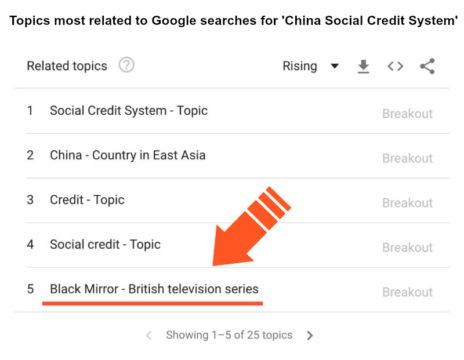
Black Mirror is a highly popular series on Netflix, of which one 2016 episode called ‘Nosedive’ revolved around a dystopian society where people are judged by a numeric rating given to them by their interactions with other people, affecting their opportunities in life. This episode is often connected to China’s SCS by Western blogs or news sites.

In the Black Mirror episode ‘Nosedive’, people’s position on the social ladder is determined by other people ranking them.
The Black Mirror association with ‘social credit’ does not only come up on Google Trends. On Twitter, for example, some of the hashtags most related to the term also includes “#blackmirror.”
In contrast to the English term, with 160 million results, the Chinese term for the social credit system (社会信用体系) comes up with only 19,2 million total search results on Google. Google Trends also shows a rather minimal interest in the Chinese term compared to its English equivalent.
Although that result is somewhat flawed (the Google search engine is blocked in mainland China), Baidu, one of China’s most popular search engines, also gives a comparatively small total of 7,7 million results for the same Chinese web search query.
All in all, there are clear indications that the attention for the Chinese Social Credit System in the international English-language online media environment is much bigger than that within China.
While the Social Credit System (SCS) is being mentioned on Twitter almost every five to ten minutes at time of writing, it is only being discussed on Weibo with intervals of minimally one or two hours by posts that are barely getting likes or comments.2
This is especially noteworthy when considering that Sina Weibo has around 100 million more monthly active users (±430 million) than Twitter has (±326 million).
So what does this all mean? How come that there is so much appetite for this topic outside of China, while inside the PRC, where the ‘system’ is well underway, there is a lesser public interest in its development?
What Actually is the Social Credit System?
In the book Social Credit Law: Principles, Rules and Cases, author Luo Peixin explains Social Credit as follows:
“Social Credit is a management system that takes big data as its basis, is supported by technological capacities, and is backed by law [legal provisions]; it is an important modern method to forward the country’s governance systems and management capabilities” (3).
Rather than one system or database, the Social Credit System is an overall policy or ideology, a mechanism of punishments and rewards, that is allegedly “meant to improve the integrity and trust level of the whole society” (creditchina.gov.cn).
In 2014, the Chinese government announced its first plans on the construction of a nationwide Social Credit System to be rolled out by 2020. For now, there is not one system in place, but rather a collection of different implementations and experiments across various regions and cities across China.
What they all have in common, though, is that individuals, corporations, or agencies are being assessed based on their ‘trustworthiness’ (Kostka 2018, 1).

In Shaanxi’s Ankan city, blacklisted trust ‘offenders’ are being publicly displayed on a local court’s LED screens this month (via http://jszx.court.gov.cn).
The past summer has seen some important developments in the realization of a national Social Credit System. In the Chinese state media article “The Credit Society is Coming, Are You Ready for It?” [“信用社会来临,你准备好了吗”], People’s Daily notes that new Social Credit terms such as “blacklists” (黑名单) will become more ubiquitous in daily life from now on.
Earlier this year, the first names on the ‘lose trust list’ (失信人名单) – meaning those who have failed in complying with their public commitments or court orders – were reported to the Chinese railway and aviation departments by the China Securities Regulatory Commission (CSRC) to block these people from traveling.
At the beginning of 2018, twelve cities have been announced as successfully laying out the foundations of a Social Credit management system.3
Other Chinese cities are frequently added to the ‘credit cities’ list. Dalian, for example, is one of the cities that is highlighted by Chinese media this month for “steadily advancing” its Social Credit System implementation. The city has introduced an automated administrative process at its Public Resources Trading Center, in which people who are found to have bad credit will automatically be refused the handling of business.
It is just one among dozens of examples of how various cities and regions in China are experimenting with Social Credit and both punitive and rewarding measures.
Besides the SCS initiatives being implemented by local governments, commercial companies are also participating in making China a more credit-based society. Users who opt in to Alibaba’s Sesame Credit loyalty program system, for example, can enjoy many benefits if they have a good credit score (650+), such as borrowing books from the local library for free, or using share bikes without deposit (more on Sesame Credit and its perks here).
According to Weibo user ‘Lawyer Ju’, the broad credit system “covers both economic credit systems and social integrity systems,” within which the blacklist system is getting “more and more important”, adding that “the joint structure of ‘lose trust in one place, and there’s no place to go’ [一处失信、处处受限] will soon be here.”
Weibo Focus: No Bad Deed Should Go Unpunished
Lawyer Ju is not the only Weibo user who seems rather optimistic and happy about the implementation of a system that governs society based on trust.
Although major discussions on the actual ‘Social Credit System’ – using that exact term (社会信用体系) – are practically non-existent on Weibo, there are other examples of trending topics linked to the system that have gone viral lately.
One noteworthy example is the topic of two ‘Train Tyrants‘ that went trending on Chinese social media since August of this year.

The two train bullies that went viral the past months.
It all started with the “Highspeed Train Tyrant” (高铁霸座男) in September. It is a nickname that was given to a man who refused to give up the seat he took from another passenger on the G334 express train to Beijing in late August, and whose bizarre and rude behavior was caught on video.
The other train bully that went viral in September, is a woman from Hunan who was dubbed ‘High-Speed Train Tyrant Woman’ (高铁霸座女) by Weibo netizens.
She had taken a seat assigned to another passenger while riding the train from Yongzhou to Shenzhen. A video (YouTube link here) shows how the woman makes a scene when the train conductor tells her she is in the wrong seat; she refuses to get up, raises her voice, talks rudely to the conductor, and simply claims she has bought a ticket and will not change to another seat until she has reached her final destination.
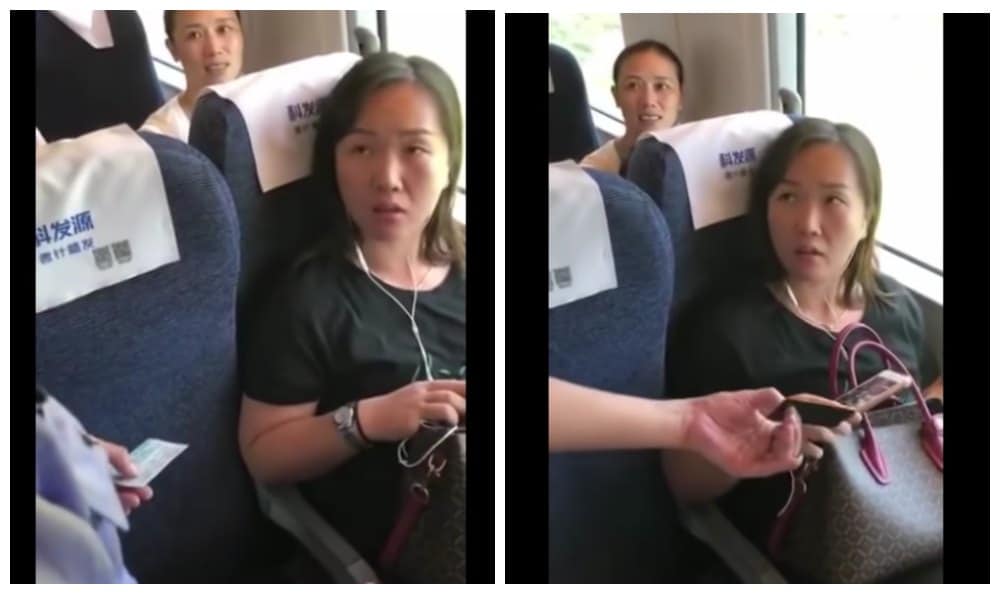
The story of this female ‘train tyrant’ became trending on Weibo with over 500 million views.
With more than 600 million combined views on the stories of the highspeed ‘Train Tyrants’, making them one of the bigger news stories of the year, the unruly behavior of passengers on Chinese public transport system made headlines. When news came out that both ‘bullies’ were fined and blacklisted by the Chinese railways (banning them from boarding trains for 180 days, see this article by Jeremy Daum for more on the legal aspects), many commenters applauded the system – although some deemed it not punitive enough (“180 days and a 200 yuan [$28] fine is nothing!“).
Although this case concerned a Railway-specific blacklist, many people commented that this blacklisting system should also be applied to people disturbing the order in hospitals, for example, and that it should be linked with the nationwide Social Credit System.
Moreover, many deemed that the Social Credit System should be even more punitive to people disturbing the public order, saying they “only had themselves to blame” (“咎由自取”), and it is a mere matter of “how karma works.”
Twitter Focus: China’s Scary Social Credit System
Meanwhile, on Twitter, a very different Social Credit story is going viral. A two-minute short video published by the Economist on October 26 titled “How Does China’s Social Credit System Work?” has more than 275,000 views on Twitter alone at time of writing (Update 23.00 China time: Economist has removed the video within hours after this article was posted).
Accompanied by suspenseful music, the video starts by captioning that by 2020, “the Chinese government will give all 1.4bn of its citizens a personal score based on how they behave.”
It further alleges that the ‘system’ will “track people’s activities on the Internet,” and that “what they buy, view, and say online will all be analysed,” followed by the claim that “this data will then be evaluated and distilled into a single number according to rules set by the government.”

Still from the Economist video.
The Economist video then focuses on surveillance cameras “that track people’s behavior in public”, suggesting that someone’s “score” could be lowered by crossing a red light, and that 12 million people have already been “punished for having a low score” through domestic travel bans.
Among thousands of reactions on the video, many compared China to an “Orwellian surveillance state” or a “Black Mirror episode.”
This recent Economist video is but one of dozens of examples of international media outlets describing China’s Social Credit System within a certain framework, mainly linking it to terms such as ‘punishment,’ ‘surveillance,’ and ‘individual scores.’
Many of these news stories suggest that every Chinese citizen will be assigned a ‘score’, or that people’s mere way behaving in public will be able to lower that ‘score’, resulting in ‘punishment’ (FYI: there is no indication that there will be one ‘score’ for citizens in a nationwide SCS, also see this article).
These stories are often grossly conflating the (optional) commercial credit systems, such as Sesame Credit, with national government policies and local experiments. (For more about this, also check this article).
Dramatically Different Approaches
By just comparing the previously mentioned examples of the Train Tyrant viral story in China, and the Economist viral video, one can get a glimpse of the great gap in (social) media approaches of the Social Credit System in China and in Western media.4
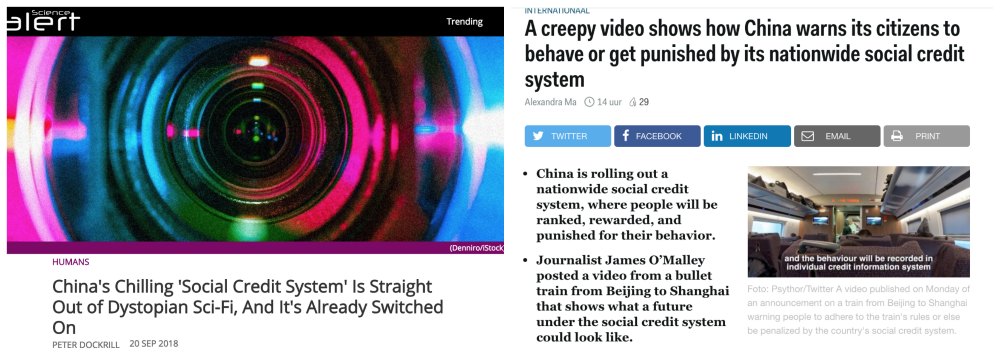
“Creepy”, “Chilling”, “Sci-fi” – some of the words used in Western media headlines to frame the SCS.
In the international media headlines, powerful emotional words like ‘chilling’, ‘creepy’, or ‘dystopian’ are often used. Perhaps not coincidentally, marketers since long know that readers react more strongly to ‘alert words’ that make us feel anxious, such as ‘afraid’, ‘scare’, ‘risk’, and ‘alarm’ – which are all great words to get more engagement with social media users, and thus will result in more clicks.
As ‘sexy’ as the SCS might seem in Western media, as ‘dry’ it can seem in the Chinese media context, where the most powerful words used in headlines are terms as ‘trust’, ‘harmony’ or ‘blacklist’, and where there are no dramatic images; occasionally there is a featured photo of officials having a meeting (to see more on how state media propagates the SCS through cartoons, click here).

A typical SCS-focused article in Chinese media.
This difference in the framing of SCS between Western publications and Chinese articles can also be seen in the specific words used in SCS-focused news stories.
The word clouds below show the most used words in three typical SCS articles from Western mainstream media (Independent, Guardian, and ABC), and three typical English-language Chinese state media articles on SCS (namely Global Times, Xinhua, and China Daily ).
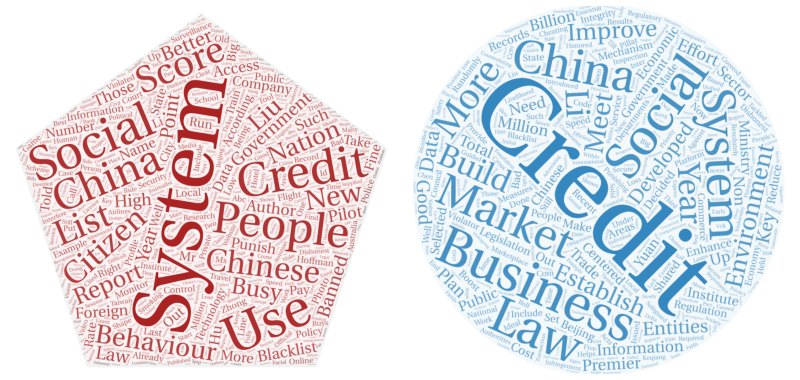
Most common words in news articles discussing the social credit system in Western media (left) and English-language Chinese media (right). (By What’s on Weibo via wordart).
While there are many words overlapping between the two examples, the most-used words in these Western media sources (left) are words as ‘system’, ‘list’, ‘citizen’, ‘behaviour’, ‘score’, and ‘government’, whereas the Chinese state media sources (right) more commonly use words as ‘business’, ‘law’, ‘market’, and ‘build.’
Doing the same experiment with Chinese-language state media articles on the SCS (Sina News, People’s Daily, and Guangming Daily) shows that ‘trust’ or ‘credit’ (信用) and ‘building’ (建设) are among the most-used words, with terms such as ‘enjoy together’, ‘cooperate’, or ‘unite’ frequently popping up.
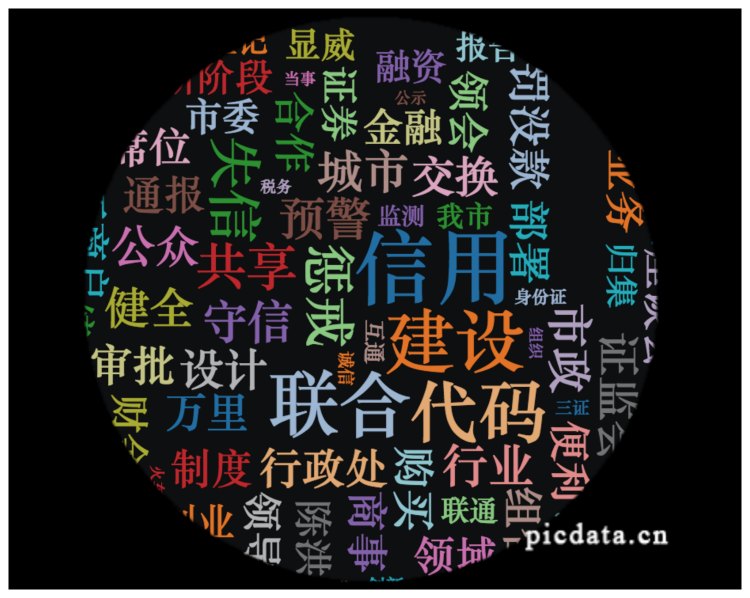
The result of the most common words used in three state media articles on SCS (Whatsonweibo via Picdata).
The different public attitude towards the SCS implementation in China versus the Western media discourse on the issue, is also illustrated in a recent study by Genia Kostka (2018), that investigates Chinese citizens’ attitudes towards social credit systems. Rather than thinking of it as a ‘creepy’ or ‘dystopian’ system, it showed that SCSs actually have very high levels of approval across the respondent groups in the study (her work can be viewed here).
Social Credit Accounts without Followers
Ever since the 2014 plans of China’s Social Credit implementation were announced, Chinese social media has seen dozens of regional, urban, district-based ‘Social Credit’ accounts pop up on Weibo and WeChat to inform netizens of local developments.
The online presence of these local social credit programmes signals that Weibo and Wechat may have hundreds of these accounts in the future informing citizens/netizens of new measures and guidelines.
However, the fanbase numbers of these accounts, again, reflect that there does not seem to be that much interest for the nascent SCS implementations.
A brief overview of some of these Weibo accounts:
* Credit Suzhou @苏州工业园区信用平台
Followers: 391
First post on record: September 29, 2015
* Liaoning Credit @信用辽宁
Followers at time of writing: 764
First post on record: August 1, 2012

* Wuhu Credit
@信用芜湖
Followers at time of writing: 14
First post on record: August 22, 2016
* Beijing City Social Credit Building Promotional Association @北京市社会公信建设促进会
Followers at time of writing: 14913
First post on record: September 17, 2014
* China Trustworthy Guangzhou @中国诚信广州
Followers at time of writing: 383
First post on record: June 20, 2012
* Honest Suqian @诚信宿迁
Followers at time of writing: 21
First post on record: September 9, 2014
With more than 24,000 followers, the Weibo account of commercial credit system Sesame Credit (@芝麻信用) is much more popular than the government-related management programmes.
Perhaps the topic of SCS, for many Chinese, is lacking the ‘Black Mirror’ appeal it has for many Western consumers of news. Perhaps ‘harmony’ and ‘trust’ are not as click-worthy as ‘creepy’ and ‘dystopian’?
On Weibo, Lawyer Ju is confident in the future of SCS in China: “Whether it’s from a social, corporate, or individual perspective,” he writes: “‘trust’ is now everywhere; it’s become a necessary ‘virtual asset.’ The gradual improvement of the construction of a legal credit system is the fundamental policy in order to regulate the market economy.”
Although his message is sound and clear, it is perhaps also somewhat boring and dry: it has not received any likes or shares to date. Meanwhile, on Twitter, the Economist‘s suspenseful video on China’s grim SCS future has received more than 280,000 views, and counting. “Oh my god!”, one popular reply to the video says: “This is just like that Black Mirror episode!”
(Update 23.00 China time: Economist has removed the video within hours after this article was posted).
By Manya Koetse
Follow @whatsonweibo
1 This article talks about ‘international’ or ‘Western’ media to show a clear difference from Chinese media. Although the term can be understood in many ways, we mean it here to address mainstream English-language (news) sources of media outlets from mainly the US, Europe, and Australia.
2 Please note that there is currently no reason to assume that discussions of this specific topic are being censored: censorship scanning sites such as Free Weibo show no signs that posts using the term are specifically targeted, and state media and local governments are actually trying to start up discussions on this topic, as I will briefly touch upon later on in this article.
3 Namely Hangzhou, Nanjing, Xiamen, Chengdu, Suzhou, Suqian, Huizhou, Wenzhou, Weihai, Weifang, Yiwu, and Rongcheng.
4 Note that these are just small examples within a big and complicated discourse that has more sides to it than this article allows to zoom in on.
References
Kostka, Genia. 2018. “China’s Social Credit Systems and Public Opinion: Explaining High Levels of Approval” SSRN, July 23. Available at https://ssrn.com/abstract=3215138 or http://dx.doi.org/10.2139/ssrn.3215138 [29.10.18].
Luo Peixin 罗培新. 2018. Social Credit Law: Principles, Rules and Cases [社会信用法:原理、规则、案例]. Beijing: Peking University Press.
People’s Daily. 2018. “Observing the Social Credit System: The Credit Society is Coming, Are You Ready for It? [观察社会信用体系:信用社会来临,你准备好了吗].” Xinhua June 4. Available online at http://www.xinhuanet.com/2018-06/04/c_1122931164.htm [29.10.18].

Directly support Manya Koetse. By supporting this author you make future articles possible and help the maintenance and independence of this site. Donate directly through Paypal here. Also check out the What’s on Weibo donations page for donations through creditcard & WeChat and for more information.
Spotted a mistake or want to add something? Please let us know in comments below or email us.
©2018 Whatsonweibo. All rights reserved. Do not reproduce our content without permission – you can contact us at info@whatsonweibo.com
Manya Koetse is the founder and editor-in-chief of whatsonweibo.com. She is a writer, public speaker, and researcher (Sinologist, MPhil) on social trends, digital developments, and new media in an ever-changing China, with a focus on Chinese society, pop culture, and gender issues. She shares her love for hotpot on hotpotambassador.com. Contact at manya@whatsonweibo.com, or follow on Twitter.

Backgrounder
“Oppenheimer” in China: Highlighting the Story of Qian Xuesen
Qian Xuesen is a renowned Chinese scientist whose life shares remarkable parallels with Oppenheimer’s.
Published
10 months agoon
September 16, 2023By
Zilan Qian
They shared the same campus, lived in the same era, and both played pivotal roles in shaping modern history while navigating the intricate interplay between science and politics. With the release of the “Oppenheimer” movie in China, the renowned Chinese scientist Qian Xuesen is being compared to the American J. Robert Oppenheimer.
In late August, the highly anticipated U.S. movie Oppenheimer finally premiered in China, shedding light on the life of the famous American theoretical physicist J. Robert Oppenheimer (1904-1967).
Besides igniting discussions about the life of this prominent scientist, the film has also reignited domestic media and public interest in Chinese scientists connected to Oppenheimer and nuclear physics.
There is one Chinese scientist whose life shares remarkable parallels with Oppenheimer’s. This is aerospace engineer and cyberneticist Qian Xuesen (钱学森, 1911-2009). Like Oppenheimer, he pursued his postgraduate studies overseas, taught at Caltech, and played a pivotal role during World War II for the US.
Qian Xuesen is so widely recognized in China that whenever I introduce myself there, I often clarify my last name by saying, “it’s the same Qian as Qian Xuesen’s,” to ensure that people get my name.
Some Chinese blogs recently compared the academic paths and scholarly contributions of the two scientists, while others highlighted the similarities in their political challenges, including the revocation of their security clearances.
The era of McCarthyism in the United States cast a shadow over Qian’s career, and, similar to Oppenheimer, he was branded as a “communist suspect.” Eventually, these political pressures forced him to return to China.
Although Qian’s return to China made his later life different from Oppenheimer’s, both scientists lived their lives navigating the complex dynamics between science and politics. Here, we provide a brief overview of the life and accomplishments of Qian Xuesen.
Departing: Going to America
Qian Xuesen (钱学森, also written as Hsue-Shen Tsien), often referred to as the “father of China’s missile and space program,” was born in Shanghai in 1911,1 a pivotal year marked by a historic revolution that brought an end to the imperial dynasty and gave rise to the Republic of China.
Much like Oppenheimer, who pursued further studies at Cambridge after completing his undergraduate education, Qian embarked on a journey to the United States following his bachelor’s studies at National Chiao Tung University (now Shanghai Jiao Tong University). He spent a year at Tsinghua University in preparation for his departure.
The year was 1935, during the eighth year of the Chinese Civil War and the fourth year of Japan’s invasion of China, setting the backdrop for his academic pursuits in a turbulent era.

Qian in his office at Caltech (image source).
One year after arriving in the U.S., Qian earned his master’s degree in aeronautical engineering from the Massachusetts Institute of Technology (MIT). Three years later, in 1939, the 27-year-old Qian Xuesen completed his PhD at the California Institute of Technology (Caltech), the very institution where Oppenheimer had been welcomed in 1927. In 1943, Qian solidified his position in academia as an associate professor at Caltech. While at Caltech, Qian helped found NASA’s Jet Propulsion Laboratory.
When World War II began, while Oppenheimer was overseeing the Manhattan Project’s efforts to assist the U.S. in developing the atomic bomb, Qian actively supported the U.S. government. He served on the U.S. government’s Scientific Advisory Board and attained the rank of lieutenant colonel.

The first meeting of the US Department of the Air Force Scientific Advisory Board in 1946. The predecessor, the Scientific Advisory Group, was founded in 1944 to evaluate the aeronautical programs and facilities of the Axis powers of World War II. Qian can be seen standing in the back, the second on the left (image source).
After the war, Qian went to teach at MIT and returned to Caltech as a full-time professor in 1949. During that same year, Mao Zedong proclaimed the establishment of the People’s Republic of China (PRC). Just one year later, the newly-formed nation became involved in the Korean War, and China fought a bloody battle against the United States.
Red Scare: Being Labeled as a Communist
Robert Oppenheimer and Qian Xuesen both had an interest in Communism even prior to World War II, attending communist gatherings and showing sympathy towards the Communist cause.
Qian and Oppenheimer may have briefly met each other through their shared involvement in communist activities. During his time at Caltech, Qian secretly attended meetings with Frank Oppenheimer, the brother of J. Robert Oppenheimer (Monk 2013).
However, it was only after the war that their political leanings became a focal point for the FBI.
Just as the FBI accused Oppenheimer of being an agent of the Soviet Union, they quickly labeled Qian as a subversive communist, largely due to his Chinese heritage. While the government did not succeed in proving that Qian had communist ties with China during that period, they did ultimately succeed in portraying Qian as a communist affiliated with China a decade later.
During the transition from the 1940s to the 1950s, the Cold War was underway, and the anti-communist witch-hunts associated with the McCarthy era started to intensify (BBC 2020).
In 1950, the Korean War erupted, with the People’s Republic of China (PRC) joining North Korea in the conflict against South Korea, which received support from the United States. It was during this tumultuous period that the FBI officially accused Qian of communist sympathies in 1950, leading to the revocation of his security clearance despite objections from Qian’s colleagues. Four years later, in 1954, Robert Oppenheimer went through a similar process.

The 1950’s security hearing of Qian (second left). (Image source).
After losing his security clearance, Qian began to pack up, saying he wanted to visit his aging parents back home. Federal agents seized his luggage, which they claimed contained classified materials, and arrested him on suspicion of subversive activity. Although Qian denied any Communist leanings and rejected the accusation, he was detained by the government in California and spent the next five years under house arrest.
Five years later, in 1955, two years after the end of the Korean War, Qian was sent home to China as part of an apparent exchange for 11 American airmen who had been captured during the war. He told waiting reporters he “would never step foot in America again,” and he kept his promise (BBC 2020).

A letter from the US Immigration and Naturalization Service to Qian Xuesen, dated August 4, 1955, in which he was notified he was allowed to leave the US. The original copy is owned by Qian Xuesen Library of Shanghai Jiao Tong University, where the photo was taken. (Caption and image via wiki).
Dan Kimball, who was the Secretary of the US Navy at the time, expressed his regret about Qian’s departure, reportedly stating, “I’d rather shoot him dead than let him leave America. Wherever he goes, he equals five divisions.” He also stated: “It was the stupidest thing this country ever did. He was no more a communist than I was, and we forced him to go” (Perrett & Bradley, 2008).
Kimball may have foreseen the unfolding events accurately. After his return to China, Qian did indeed assume a pivotal role in enhancing China’s military capabilities, possibly surpassing the potency of five divisions. The missile programme that Qian helped develop in China resulted in weapons which were then fired back on America, including during the 1991 Gulf War (BBC 2020).
Returning: Becoming a National Hero
The China that Qian Xuesen had left behind was an entirely different China than the one he returned to. China, although having relatively few experts in the field, was embracing new possibilities and technologies related to rocketry and space exploration.
Within less than a month of his arrival, Qian was welcomed by the then Vice Prime Minister Chen Yi, and just four months later, he had the honor of meeting Chairman Mao himself.

Qian and Mao (image source).
In China, Qian began a remarkably successful career in rocket science, with great support from the state. He not only assumed leadership but also earned the distinguished title of the “father” of the Chinese missile program, instrumental in equipping China with Dongfeng ballistic missiles, Silkworm anti-ship missiles, and Long March space rockets.
Additionally, his efforts laid the foundation for China’s contemporary surveillance system.
By now, Qian has become somewhat of a folk hero. His tale of returning to China despite being thwarted by the U.S. government has become like a legendary narrative in China: driven by unwavering patriotism, he willingly abandoned his overseas success, surmounted formidable challenges, and dedicated himself to his motherland.
Throughout his lifetime, Qian received numerous state medals in recognition of his work, establishing him as a nationally celebrated intellectual. From 1989 to 2001, the state-launched public movement “Learn from Qian Xuesen” was promoted throughout the country, and by 2001, when Qian turned 90, the national praise for him was on a similar level as that for Deng Xiaoping in the decade prior (Wang 2011).
Qian Xuesen remains a celebrated figure. On September 3rd of this year, a new “Qian Xuesen School” was established in Wenzhou, Zhejiang Province, becoming the sixth high school bearing the scientist’s name since the founding of the first one only a year ago.

In 2017, the play “Qian Xuesen” was performed at Qian’s alma mater, Shanghai Jiaotong University. (Image source.)
Qian Xuesen’s legacy extends well beyond educational institutions. His name frequently appears in the media, including online articles, books, and other publications. There is the Qian Xuesen Library and a museum in Shanghai, containing over 70,000 artefacts related to him. Qian’s life story has also been the inspiration for a theater production and a 2012 movie titled Hsue-Shen Tsien (钱学森).2
Unanswered Questions
As is often the case when people are turned into heroes, some part of the stories are left behind while others are highlighted. This holds true for both Robert Oppenheimer and Qian Xuesen.
The Communist Party of China hailed Qian as a folk hero, aligning with their vision of a strong, patriotic nation. Many Chinese narratives avoid the debate over whether Qian’s return was linked to problems and accusations in the U.S., rather than genuine loyalty to his homeland.
In contrast, some international media have depicted Qian as a “political opportunist” who returned to China due to disillusionment with the U.S., also highlighting his criticism of “revisionist” colleagues during the Cultural Revolution and his denunciation of the 1989 student demonstrations.
Unlike the image of a resolute loyalist favored by the Chinese public, Qian’s political ideology was, in fact, not consistently aligned, and there were instances where he may have prioritized opportunity over loyalty at different stages of his life.
Qian also did not necessarily aspire to be a “flawless hero.” Upon returning to China, he declined all offers to have his biography written for him and refrained from sharing personal information with the media. Consequently, very little is known about his personal life, leaving many questions about the motivations driving him, and his true political inclinations.

The marriage photo of Qian and Jiang. (Image source).
We do know that Qian’s wife, Jiang Ying (蒋英), had a remarkable background. She was of Chinese-Japanese mixed race and was the daughter of a prominent military strategist associated with Chiang Kai-shek. Jiang Ying was also an accomplished opera singer and later became a professor of music and opera at the Central Conservatory of Music in Beijing.
Just as with Qian, there remain numerous unanswered questions surrounding Oppenheimer, including the extent of his communist sympathies and whether these sympathies indirectly assisted the Soviet Union during the Cold War.
Perhaps both scientists never imagined they would face these questions when they first decided to study physics. After all, they were scientists, not the heroes that some narratives portray them to be.
Also read:
■ Farewell to a Self-Taught Master: Remembering China’s Colorful, Bold, and Iconic Artist Huang Yongyu
■ “His Name Was Mao Anying”: Renewed Remembrance of Mao Zedong’s Son on Chinese Social Media
By Zilan Qian
Follow @whatsonweibo
1 Some sources claim that Qian was born in Hangzhou, while others say he was born in Shanghai with ancestral roots in Hangzhou.
2The Chinese character 钱 is typically romanized as “Qian” in Pinyin. However, “Tsien” is a romanization in Wu Chinese, which corresponds to the dialect spoken in the region where Qian Xuesen and his family have ancestral roots.
This article has been edited for clarity by Manya Koetse
References (other sources hyperlinked in text)
BBC. 2020. “Qian Xuesen: The man the US deported – who then helped China into space.” BBC.com, 27 October https://www.bbc.com/news/stories-54695598 [9.16.23].
Monk, Ray. 2013. Robert Oppenheimer: A Life inside the Center, First American Edition. New York: Doubleday.
Perrett, Bradley, and James R. Asker. 2008. “Person of the Year: Qian Xuesen.” Aviation Week and Space Technology 168 (1): 57-61.
Wang, Ning. 2011. “The Making of an Intellectual Hero: Chinese Narratives of Qian Xuesen.” The China Quarterly, 206, 352-371. doi:10.1017/S0305741011000300
Get the story behind the hashtag. Subscribe to What’s on Weibo here to receive our newsletter and get access to our latest articles:
Spotted a mistake or want to add something? Please let us know in comments below or email us. First-time commenters, please be patient – we will have to manually approve your comment before it appears.
©2023 Whatsonweibo. All rights reserved. Do not reproduce our content without permission – you can contact us at info@whatsonweibo.com.
Backgrounder
Farewell to a Self-Taught Master: Remembering China’s Colorful, Bold, and Iconic Artist Huang Yongyu
Renowned Chinese artist and the creator of the ‘Blue Rabbit’ zodiac stamp Huang Yongyu has passed away at the age of 98. “I’m not afraid to die. If I’m dead, you may tickle me and see if I smile.”
Published
1 year agoon
June 15, 2023
The famous Chinese painter, satirical poet, and cartoonist Huang Yongyu has passed away. Born in 1924, Huang endured war and hardship, yet never lost his zest for life. When his creativity was hindered and his work was suppressed during politically tumultuous times, he remained resilient and increased “the fun of living” by making his world more colorful.
He was a youthful optimist at old age, and will now be remembered as an immortal legend. The renowned Chinese painter and stamp designer Huang Yongyu (黄永玉) passed away on June 13 at the age of 98. His departure garnered significant attention on Chinese social media platforms this week.
On Weibo, the hashtag “Huang Yongyu Passed Away” (#黄永玉逝世#) received over 160 million views by Wednesday evening.
Huang was a member of the China National Academy of Painting (中国国家画院) as well as a Professor at the Central Academy of Fine Arts (中央美术学院).
Huang Yongyu is widely recognized in China for his notable contribution to stamp design, particularly for his iconic creation of the monkey stamp in 1980. Although he designed a second monkey stamp in 2016, the 1980 stamp holds significant historical importance as it marked the commencement of China Post’s annual tradition of releasing zodiac stamps, which have since become highly regarded and collectible items.

Huang’s famous money stamp that was issued by China Post in 1980.
The monkey stamp designed by Huang Yongyu has become a cherished collector’s item, even outside of China. On online marketplaces like eBay, individual stamps from this series are being sold for approximately $2000 these days.
Huang Yongyu’s latest most famous stamp was this year’s China Post zodiac stamp. The stamp, a blue rabbit with red eyes, caused some online commotion as many people thought it looked “horrific.”
Some thought the red-eyed blue rabbit looked like a rat. Others thought it looked “evil” or “monster-like.” There were also those who wondered if the blue rabbit looked so wild because it just caught Covid.

Huang’s (in)famous blue rabbit stamp.
Nevertheless, many people lined up at post offices for the stamps and they immediately sold out.
In light of the controversy, Huang Yongyu spoke about the stamps in a livestream in January of 2023. The 98-year-old artist claimed he had simply drawn the rabbit to spread joy and celebrate the new year, stating, “Painting a rabbit stamp is a happy thing. Everyone could draw my rabbit. It’s not like I’m the only one who can draw this.”
Huang’s response also went viral, with one Weibo hashtag dedicated to the topic receiving over 12 million views (#蓝兔邮票设计者直播回应争议#) at the time. Those defending Huang emphasized how it was precisely his playful, light, and unique approach to art that has made Huang’s work so famous.
A Self-Made Artist
“I’m ugly, but my mum likes me”

‘Ugly Mouse’ by Huang Yongyu [Image via China Daily].
Huang Yongyu was born on August 9, 1924, in Hunan’s Chengde as a native of the Tujia ethnic group.
He was born into an extraordinary family. His grandfather, Huang Jingming (黄镜铭), worked for Xiong Xiling (熊希齡), who would become the Premier of the Republic of China. His first cousin and lifelong friend was the famous Chinese novelist Shen Congwen (沈从文). Huang’s father studied music and art and was good at drawing and playing the accordion. His mother graduated from the Second Provincial Normal School and was the first woman in her county to cut her hair short and wear a short skirt (CCTV).
Born in times of unrest and poverty, Huang never went to college and was sent away to live with relatives at the age of 13. His father would die shortly after, depriving him of a final goodbye. Huang started working in various places and regions, from porcelain workshops in Dehua to artisans’ spaces in Quanzhou. At the age of 16, Huang was already earning a living as a painter and woodcutter, showcasing his talents and setting the foundation for his future artistic pursuits.
When he was 22, Huang married his first girlfriend Zhang Meixi (张梅溪), a general’s daughter, with whom he shared a love for animals. He confessed his love for her when they both found themselves in a bomb shelter after an air-raid alarm.

Huang and Zhang Meixi [163.com]
In his twenties, Huang Yongyu emerged as a sought-after artist in Hong Kong, where he had relocated in 1948 to evade persecution for his left-wing activities. Despite achieving success there, he heeded Shen Congwen’s advice in 1953 and moved to Beijing. Accompanied by his wife and their 7-month-old child, Huang took on a teaching position at the esteemed Central Academy of Fine Arts (中央美术学院).
The couple raised all kinds of animals at their Beijing home, from dogs and owls to turkeys and sika deers, and even monkeys and bears (Baike).
Throughout Huang’s career, animals played a significant role, not only reflecting his youthful spirit but also serving as vehicles for conveying satirical messages.
One recurring motif in his artwork was the incorporation of mice. In one of his famous works, a grey mouse is accompanied by the phrase ‘I’m ugly, but my mum likes me’ (‘我丑,但我妈喜欢’), reinforcing the notion that regardless of our outward appearance or circumstances, we remain beloved children in the eyes of our mothers.

As a teacher, Huang liked to keep his lessons open-minded and he, who refused to join the Party himself, stressed the importance of art over politics. He would hold “no shirt parties” in which his all-male studio students would paint in an atmosphere of openness and camaraderie during hot summer nights (Andrews 1994, 221; Hawks 2017, 99).
By 1962, creativity in the classroom was limited and there were far more restrictions to what could and could not be created, said, and taught.
Bright Colors in Dark Times
“Strengthen my resolve and increase the fun of living”
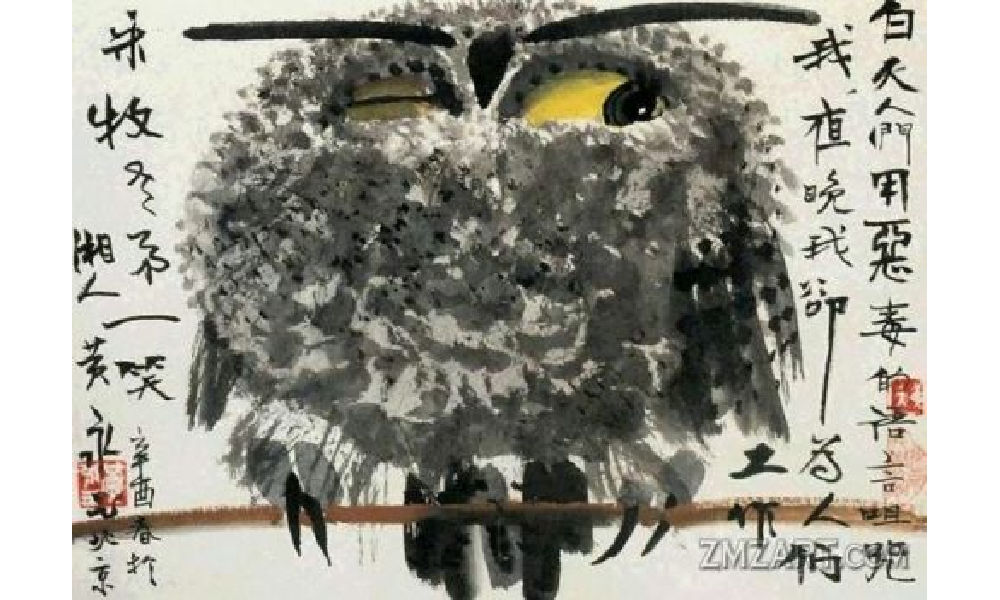
Huang Yongyu’s winking owl, 1973, via Wikiart.
In 1963, Huang was sent to the countryside as part of the “Four Cleanups” movement (四清运动, 1963-1966). Although Huang cooperated with the requirement to attend political meetings and do farm work, he distanced himself from attempts to reform his thinking. In his own time, and even during political meetings, he would continue to compose satirical and humorous pictures and captions centered around animals, which would later turn into his ‘A Can of Worms’ series (Hawks 2017, 99; see Morningsun.org).
Three years later, at the beginning of the Cultural Revolution, many Chinese major artists, including Huang, were detained in makeshift jails called ‘niupeng‘ (牛棚), cowsheds. Huang’s work was declared to be counter-revolutionary, and he was denounced and severely beaten. Despite the difficult circumstances, Huang’s humor and kindness would remind his fellow artist prisoners of the joy of daily living (2017, 95-96).
After his release, Huang and his family were relocated to a cramped room on the outskirts of Beijing. The authorities, thinking they could thwart his artistic pursuits, provided him with a shed that had only one window, which faced a neighbor’s wall. However, this limitation didn’t deter Huang. Instead, he ingeniously utilized vibrant pigments that shone brightly even in the dimly lit space.
During this time, he also decided to make himself an “extra window” by creating an oil painting titled “Eternal Window” (永远的窗户). Huang later explained that the flower blossoms in the paining were also intended to “strengthen my resolve and increase the fun of living” (Hawks 2017, 4; 100-101).

Huang Yongyu’s Eternal Window [Baidu].
In 1973, during the peak of the Cultural Revolution, Huang painted his famous winking owl. The calligraphy next to the owl reads: “During the day people curse me with vile words, but at night I work for them” (“白天人们用恶毒的语言诅咒我,夜晚我为他们工作”) (Matthysen 2021, 165).
The painting was seen as a display of animosity towards the regime, and Huang got in trouble for it. Later on in his career, however, Huang would continue to paint owls. In 1977, when the Cultural Revolution had ended, Huang Yongyu painted other owls to ridicules his former critics (2021, 174).

According to art scholar Shelly Drake Hawks, Huang Yongyu employed animals in his artwork to satirize the realities of life under socialism. This approach can be loosely compared to George Orwell’s famous novel Animal Farm.
However, Huang’s artistic style, vibrant personal life, and boundary-pushing work ethic also draw parallels to Picasso. Like Picasso, Huang embraced a colorful life, adopted an innovative approach to art, and challenged artistic norms.
An Optimist Despite All Hardships
“Quickly come praise me, while I’m still alive”

Huang Yongyu will be remembered in China with love and affection for numerous reasons. Whether it is his distinctive artwork, his mischievous smile and trademark pipe, his unwavering determination to follow his own path despite the authorities’ expectations, or his enduring love for his wife of over 75 years, there are countless aspects to appreciate and admire about Huang.
One things that is certainly admirable is how he was able to maintain a youthful and joyful attitude after suffering many hardships and losing so many friends.
“An intriguing soul. Too wonderful to describe,” one Weibo commenter wrote about Huang, sharing pictures of Huang Yongyu’s “Scenes of Pooping” (出恭图) work.
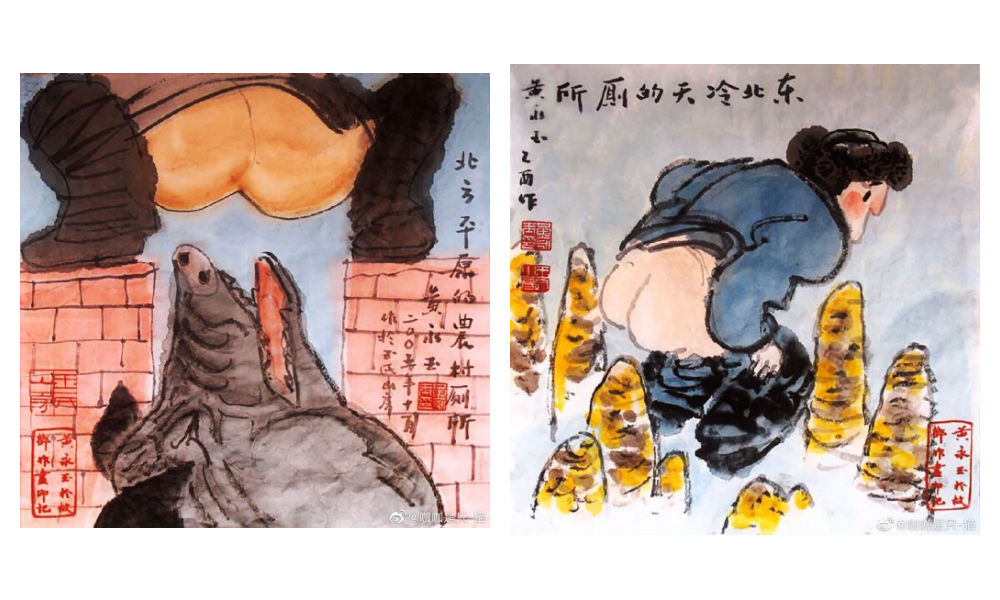
Old age did not hold him back. At the age of 70, his paintings sold for millions. When he was in his eighties, he was featured on the cover of Esquire (时尚先生) magazine.
At the age of 82, he stirred controversy in Hong Kong with his “Adam and Eve” sculpture featuring male and female genitalia, leading to complaints from some viewers. When confronted with the backlash, Huang answered, “I just wanted to have a taste of being sued, and see how the government would react” (Ora Ora).
I'm guessing the 98-year-old Huang loved the controversy. When confronted with backlash for his sculpture featuring male and female genitalia in 2007 Hong Kong, Huang answered, "I just wanted to have a taste of being sued, and see how the government would react." pic.twitter.com/kG0MVVM4SN
— Manya Koetse (@manyapan) June 15, 2023
In his nineties, he started driving a Ferrari. He owned mansions in his hometown in Hunan, in Beijing, in Hong Kong, and in Italy – all designed by himself (Chen 2019).
Huang kept working and creating until the end of his life. “It’s good to work diligently. Your work may be meaningful. Maybe it won’t be. Don’t insist on life being particularly meaningful. If it’s happy and interesting, then that’s great enough.”

“Hometown Scenery” or rather “Hunan Scenery” (湘西风景) by Huang.
Huang did not dread the end of his life.
“My old friends have all died, I’m the only one left,” he said at the age of 95. He wrote his will early and decided he wanted a memorial service for himself before his final departure. “Quickly come praise me, while I’m still alive,” he said, envisioning himself reclining on a chair in the center of the room, “listening to how everyone applauds me” (CCTV, Sohu).
He stated: “I don’t fear death at all. I always joke that when I die, you should tickle me first and see if I’ll smile” (“对死我是一点也不畏惧,我开玩笑,我等死了之后先胳肢我一下,看我笑不笑”).

Huang with Yiwo (伊喔), the original model for the monkey stamp [Shanghai Observer].
Huang also was not sentimental about what should happen to his ashes. In a 2019 article in Guangming Daily, it was revealed that he suggested to his wife the idea of pouring his ashes into the toilet and flushing them away with the water.
However, his wife playfully retorted, saying, “No, that won’t do. Your life has been too challenging; you would clog the toilet.”
To this, Huang responded, “Then wrap my ashes into dumplings and let everyone [at the funeral] eat them, so you can tell them, ‘You’ve consumed Huang Yongyu’s ashes!'”
But she also opposed of that idea, saying that they would vomit and curse him forever.
Nevertheless, his wife expressed opposition to this idea, citing concerns that it would cause people to vomit and curse him indefinitely.
In response, Huang declared, “Then let’s forget about my ashes. If you miss me after I’m gone, just look up at the sky and the clouds.” Eventually, his wife would pass away before him, in 2020, at the age of 98, having spent 77 years together with Huang.
Huang will surely be missed. Not just by the loved ones he leaves behind, but also by millions of his fans and admirers in China and beyond.
“We will cherish your memory, Mr. Huang,” one Weibo blogger wrote. Others honor Huang by sharing some of his famous quotes, such as, “Sincerity is more important than skill, which is why birds will always sing better than humans” (“真挚比技巧重要,所以鸟总比人唱得好”).
Among thousands of other comments, another social media user bid farewell to Huang Yongyu: “Our fascinating Master has transcended. He is now a fascinating soul. We will fondly remember you.”
By Manya Koetse
Get the story behind the hashtag. Subscribe to What’s on Weibo here to receive our newsletter and get access to our latest articles:
References
Andrews, Julia Frances. 1994. Painters and Politics in the People’s Republic of China, 1949-1979. Berkley: University of California Press.
Baike. “Huang Yongyu 黄永玉.” Baidu Baike https://baike.baidu.com/item/%E9%BB%84%E6%B0%B8%E7%8E%89/1501951 [June 14, 2023].
CCTV. 2023. “Why Everyone Loves Huang Yongyu [为什么人人都爱黄永玉].” WeChat 央视网 June 14.
Chen Hongbiao 陈洪标. 2019. “Most Spicy Artist: Featured in a Magazine at 80, Flirting with Lin Qingxia at 91, Playing with Cars at 95, Wants Memorial Service While Still Alive [最骚画家:80岁上杂志,91岁撩林青霞,95岁玩车,活着想开追悼会].” Sohu/Guangming Daily March 16: https://www.sohu.com/a/301686701_819105 [June 15, 2023].
Hawks, Shelley Drake. 2017. The Art of Resistance Painting by Candlelight in Mao’s China. Seattle: University of Washington Press.
Matthysen, Mieke. 2021. Ignorance is Bliss: The Chinese Art of Not Knowing. Palgrave Macmillan.
Ora Ora. “HUANG YONGYU 黃永玉.” Ora Ora https://www.ora-ora.com/artists/103-huang-yongyu/ [June 15, 2023].
Spotted a mistake or want to add something? Please let us know in comments below or email us. First-time commenters, please be patient – we will have to manually approve your comment before it appears.
©2023 Whatsonweibo. All rights reserved. Do not reproduce our content without permission – you can contact us at info@whatsonweibo.com.
Subscribe

Weibo Watch: The Future is Here

“Bye Bye Biden”: Biden’s Many Nicknames in Chinese

Enjoying the ‘Sea’ in Beijing’s Ditan Park

A Triumph for “Comrade Trump”: Chinese Social Media Reactions to Trump Rally Shooting

Weibo Watch: Get Up, Stand Up

The Tragic Story of “Fat Cat”: How a Chinese Gamer’s Suicide Went Viral

“Old Bull Eating Young Grass”: 86-Year-Old Chinese Painter Fan Zeng Marries 36-Year-Old Xu Meng

A Brew of Controversy: Lu Xun and LELECHA’s ‘Smoky’ Oolong Tea

Singing Competition or Patriotic Fight? Hunan TV’s ‘Singer 2024’ Stirs Nationalistic Sentiments

Zara Dress Goes Viral in China for Resemblance to Haidilao Apron

Weibo Watch: The Battle for the Bottom Bed

About the “AI Chatbot Based on Xi Jinping” Story

China’s Intensified Social Media Propaganda: “Taiwan Must Return to Motherland”

Weibo Watch: Telling China’s Stories Wrong

Saying Goodbye to “Uncle Wang”: Wang Wenbin Becomes Chinese Ambassador to Cambodia
Get in touch
Would you like to become a contributor, or do you have any tips or suggestions? Get in touch here!
Popular Reads
-

 China Insight3 months ago
China Insight3 months agoThe Tragic Story of “Fat Cat”: How a Chinese Gamer’s Suicide Went Viral
-

 China Music4 months ago
China Music4 months agoThe Chinese Viral TikTok Song Explained (No, It’s Not About Samsung)
-

 China Digital10 months ago
China Digital10 months agoToo Sexy for Weibo? Online Discussions on the Concept of ‘Cābiān’
-

 China Arts & Entertainment12 months ago
China Arts & Entertainment12 months agoBehind 8 Billion Streams: Who is Dao Lang Cursing in the Chinese Hit Song ‘Luocha Kingdom’?






Ed Sander
October 30, 2018 at 4:20 pm
In the meantime The Economist has removed the video from their Twitter feed …
Marco
October 31, 2018 at 8:58 am
Manya, thanks for this very insightful article.
soundcloud converter
March 15, 2019 at 5:06 am
Thanks, quite great article.